In 1999, Frank Daignault’s book The Trophy Striper was released. Chapter five is on fly fishing and to quote Frank, “a myth I should dispel is that fly fishing is light tackle, that it is schoolie fishing.”
Twenty years later, this myth is still alive and well, and I have found that most fly rodders I meet believe you can only catch big stripers from a boat or casting plugs to tease big fishing into fly rod range from shore. My first real attempt at striper fishing on the fly rod was in 2005 after graduating from West Point.
I spent one full week living in North Truro and fishing Race Point, Head of the Meadow, and Coast Guard Beach. In preparation for that trip I read Ed Mitchell’s Fly Rodding the Coast, and I set up my eight-weight with a shooting head system with floating and different sinking rate heads.
We fished sunrise to sunset and had some days where we caught 100+ striped bass each, but the trip failed to yield a single fish over 24 inches.
Later, after the trip, I realized some of the chapters I had skipped, such as the one on night fishing, may have held the answers to why I failed to catch any quality fish on the trip.
I would not get the chance to come back to the Northeast for stripers until eight years later, when my wife and I moved to her home of the Greater Boston area.
I spent 2013 chasing bass, primarily in daylight all over Cape Cod and, despite a lot more angling days than 2005, failed to produce one keeper bass on a fly rod. I realized at this point I needed most likely to get into night fishing which I was not a total stranger to.
Growing up fishing small ponds for largemouths, I figured out that July and August required fishing between 11 pm and 3 am to produce the biggest biggest bass on those months. My dad actually did not believe my stories.
So, one night I took him out and when he saw four fish between four to six pounds come to hand on large black buzzbaits, he was thoroughly convinced the stories were real. Also, after 12 years in the military, I was used to operating at night with and without night vision devices. So, heading off into the woods or beach at night was not that intimidating to me.
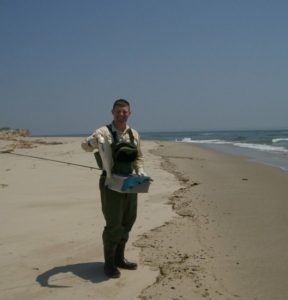
I decided to find someone to help me get into night striper fishing on a fly. So, I hired a guide that specialized in that. I fished three trips in 2014 with him, and the second trip was really eye opening to me.
We came upon huge fish gorging on sand eels in calf deep water around 2:30 am, and the activity lasted until 4 am around slack tide.
I struggled a lot with casting in the dark, and I had decided to use the guide’s rod. Looking back on it, that was a mistake, and I highly recommend that you always use the rod you are most competent casting for your initial forays into fishing at night. Trying to figure out casting issues at night is a nightmare.
I ended up setting my personal best twice that night with a 36″ fish followed by a 37″ inch fish. But, the thing that surprised me the most was that, as the sun started to come up and tide was moving again, we started to catch plenty of bass again, but I could not catch quality fish and was once again stuck in schoolie land.
Five years after that first night fishing success, I have been keeping a very detailed log and, with the exception of five fish caught while sight fishing during the day, I have not caught any other striped bass over 30″ in daylight on fly gear.
I primarily fish two-to-three hour-long trips at 10 pm to 6 am, and I have been refining tactics and methods with continuing higher success. I am ending 2018 with 36 total keeper-sized bass on a fly, with 18 fish over 30″ and two over 40″. I finally I feel like I am starting to crack the big fish code at night.
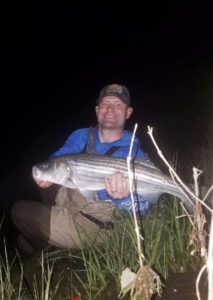
I have a very extensive striper book library and, among all 12 books I have, I could find only 41 pages total on night fishing. Most of it was the same information, just in a different book with generic guidance about going out at night.
Clearly there is a pretty major knowledge gap out there, and I think this is what is keeping the myth alive that “fly rods are for schoolies.”
I am focusing my writing efforts for this blog solely on night fishing for big striped bass. You can expect one focused article per month tackling night-specific tackle, tactics, and the many different strategies for fly fishing for large stripers.
Hopefully, by the end of the off season, you will have more information at your disposal than I had when I started this endeavor five years ago. Also, I recommend joining Stripers Online. Feel free to look me up on there as “The Graveyard Shift” or on Instagram as @canalflyguy.
I am happy to answer any direct questions, and my quest is to get many anglers to fly fishing at night and successfully catching keeper-sized or larger bass. I have yet to run into one fly fisherman at night in any area I have fished in the past five years. While I don’t want to get crowded, I would love to start seeing other fly anglers out there in the dark chasing big bass.
Discover more from BlogFlyFish.com
Subscribe to get the latest posts sent to your email.

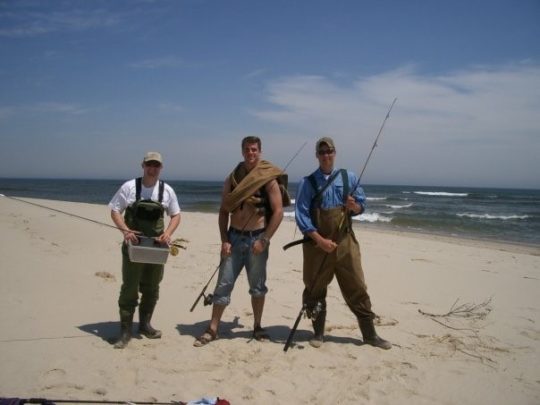
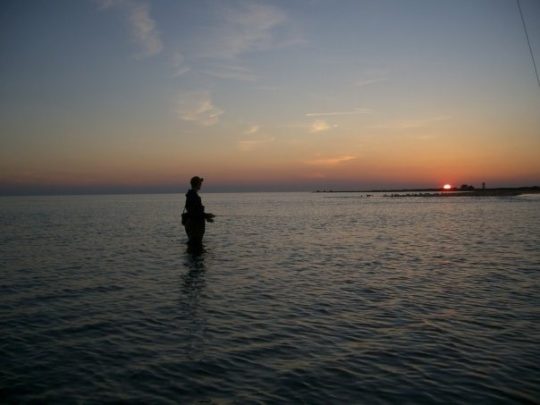

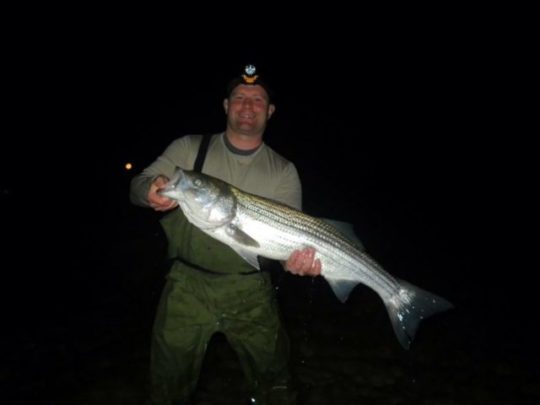



Great write up! Night time is the right time!
Thanks for the great article. Living in the Pioneer valley means that getting to the coast for night trips is kinda hard, but now that i have such good evidence about it, I can’t make any excuses. Maybe I will run into you out there some time!
Joe,
One of the articles I write is going to cover planning and logistics of how to develop night areas for traveling anglers. My assumption is a lot of people want to do this, but don’t know how to do this due to being away from the coast. It helps you understand how to do the right kind of analysis online and then how ideally to plan a weekend trip to develop a night pattern. I think this will be right up your alley.
I proved out the concepts for the article this year by picking two areas I had never been to on the Cape using this research method then fishing Saturday day and then Sunday night in the same time window. One trip produced one 33 inch fish a couple of mid twenty inch fish and the other trip produced a 28″ and 29″ fish with 8 smaller schoolies. To connect with keeper fish in a new area on both first night attempts validates the research and planning methods.
You will of course need to work on your night casting skills, because even in the right spot if you are struggling in the dark to make casts and keep contact with fly you will have poor results. Since you are in the pioneer valley I would highly encourage you to try some night fly fishing with your striper rod on the Connecticut River and its tributaries. I follow @smellyfisherman on instagram and he does a lot of night fly fishing catching walleye, pike, carp, catfish, and striped bass on undisclosed waters in that same valley you live in. A lot of the principles in the artricles I am writing could be applied to freshwater except you don’t have tidal movement. It would be a great place to learn and grow your night fishing skills close to home so you are ready when you hit the striper coast for your big trip. IT IS VERY IMPORTANT TO USE THE SAME ROD/LINE SET UP. Get super comfortable with one rod 8 or 9 weight so its your go to rod for night fishing.
The biggest concept in the traveling angler post is how to pic one area on Cape Cod or elsewhere in New England that has characteristics that will provide good spring run, summer, and fall run locations. Then keep going back to that same area for every visit to the striper coast for example Chatham. It is tempting to try covering a lot of ground say from Chatham all the way to the National Seashore, but you are much better off focusing on area exclusively over time it will yield more big bass if you focus on that one location over and over again.
Dude. THANK YOU SO MUCH, That is great advice. Stick that in another article for sure! I really appreciate all the help and writing you lay out!
Really helpful, Dan! I learn so much from your posts.
Thanks. Will keep them coming need more fly guys on the night shift!
Interesting, I have been doing quite a bit of daytime fly fishing for stripers this year and my biggest fish was 24 inches.
Mike the good news is you can easily convert areas you are already having success during the day into night fishing success. My suggestion is shoot me a DM on instagram @canalflyguy
We can discuss specifics about the locations you are currently fishing and I can help you figure out how to best target those specific locations at night. I have done this for two other guys this year and both of them have now caught a fish or two over 30 inches at night.
That’s very generous of you. I will do that.
Really inspires me to put my efforts in at night. I caught only one keeper sized bass this year and guess what, it was at night! Do you find success on beaches or do you focus on inlets and estuaries?
Tight Lines,
Brian
Brian,
I have had success in all types of environments. I will break down each one with a night perspective. The best way to describe catching big bass is its a gradual evolution you have to undertake. I will say that if you are looking to catch fish typically 25-35 inches you can stay in estuaries most of the year and accomplish this. If you want to start getting fish over 40 inches inlets are the best option. They don’t have to be crazy deep inlets but have good current and access to ocean water deeper than 40 feet within a quarter mile of the inlet. Both fish over 40 inches on the fly this year were caught in inlet conditions. Beaches I am still cracking the code on as far as catching big fish, but what I am finding is there is more complexity because surf conditions are what brings the big fish into feed on beaches. Predicting what makes a beach fish well from a surf perspective takes longer than an inlet because current and tides are very predictable. Beaches require understanding swell and wind direction interaction. I probably need three or four more seasons before I am confident writing recommendations on beach conditions that produce the best night fishing for big fish.